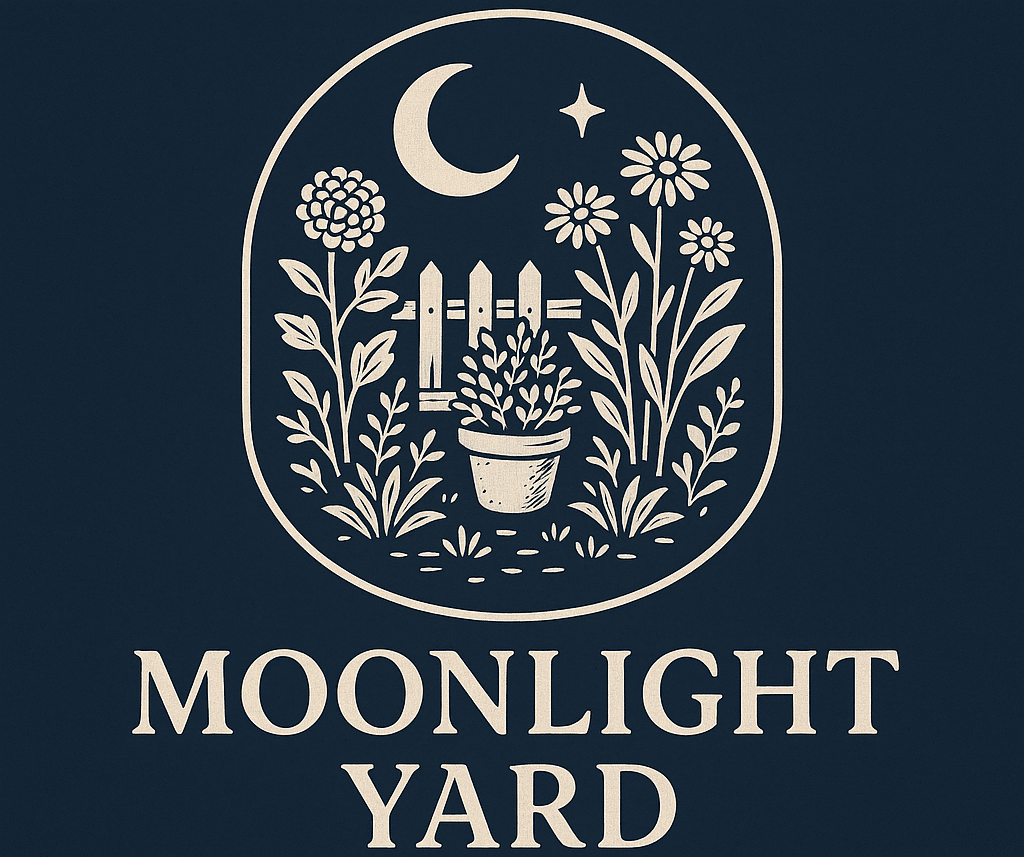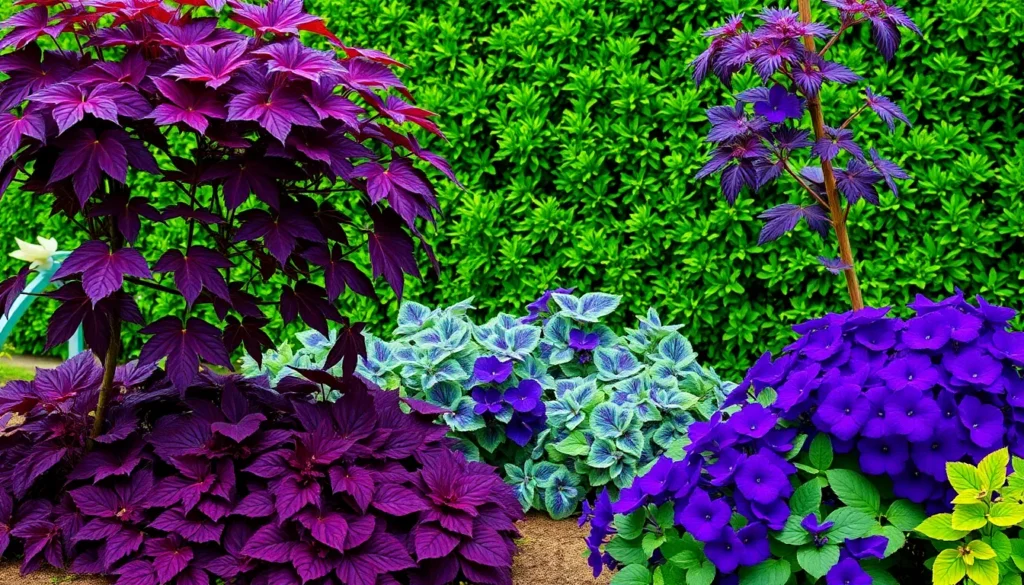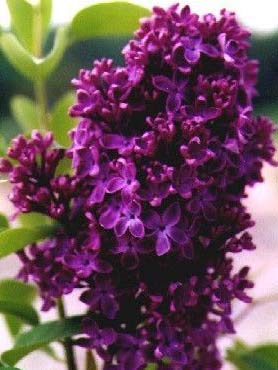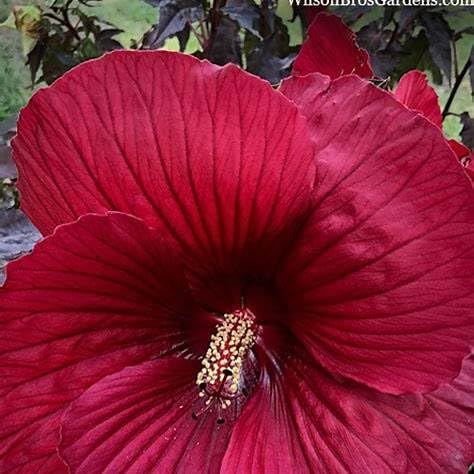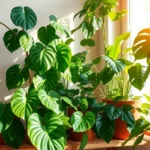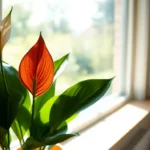Purple foliage transforms ordinary gardens into extraordinary masterpieces. We’ve all witnessed the captivating power of deep burgundy leaves dancing in sunlight or rich plum-colored stems creating dramatic focal points throughout landscapes. These stunning purple leaf plants don’t just add color – they revolutionize entire garden designs with their bold presence.
Nature’s palette extends far beyond traditional greens and we’re here to explore the magnificent industry of purple-leafed varieties that’ll make your neighbors stop and stare. From compact houseplants perfect for indoor spaces to towering trees that command attention in large yards these remarkable specimens offer endless possibilities for creative gardening.
Whether you’re a seasoned horticulturist or just beginning your plant journey we’ll guide you through the most striking purple leaf plants that thrive in various conditions. Get ready to discover how these violet-hued beauties can elevate your space from ordinary to absolutely breathtaking.
Top Purple Leaf Plants for Indoor Spaces
Creating stunning indoor displays becomes effortless when we incorporate these purple foliage champions into our homes.
African Violet (Saintpaulia)
African violets showcase deep purple leaves with velvety textures that transform any windowsill into a royal display. We love their compact rosette formation that rarely exceeds 6 inches in diameter, making them perfect for small spaces like desks, shelves, and coffee tables.
Their fuzzy purple tinged foliage creates striking contrasts against delicate flowers that bloom in shades of violet, pink, and white. Growing these beauties requires bright indirect light and consistent moisture levels, with temperatures between 65-75°F producing the most vibrant leaf coloration.
Watering from the bottom prevents leaf damage while maintaining the rich purple undertones that make these plants so desirable. Regular feeding every 2-3 weeks with diluted fertilizer keeps their distinctive coloring at peak intensity throughout the growing season.
Purple Passion Plant (Gynura aurantiaca)
Purple passion plants feature cascading stems covered in soft purple hairs that shimmer under indoor lighting. We recommend them for hanging baskets where their trailing habit creates dramatic purple waterfalls that can extend 2-3 feet in length.
Their green leaves appear completely purple due to dense violet colored fuzz covering every surface, creating an almost iridescent effect in bright conditions. Fast growing nature means we can pinch back stems regularly to maintain compact shapes while encouraging bushier purple growth patterns.
Bright indirect sunlight intensifies their purple coloration while preventing the stretching that occurs in low light environments. Moderate watering allows soil to dry slightly between sessions, preventing root rot while maintaining the lush purple appearance that makes this plant a showstopper.
Tradescantia Zebrina
Tradescantia zebrina displays silver striped leaves with deep purple undersides that create stunning two toned effects in our indoor gardens. We appreciate their rapid spreading habit that fills containers quickly, producing cascading purple streams perfect for elevated planters and hanging displays.
Their succulent like stems store water efficiently while producing new purple growth nodes every few inches along trailing branches. Pinching growing tips encourages fuller development and prevents legginess that can diminish the rich purple coloration we desire.
Bright filtered light brings out the most intense purple hues on leaf undersides while silver stripes on top surfaces create beautiful contrasts. These hardy specimens tolerate various indoor conditions but reward us with deeper purple tones when given consistent care and adequate lighting conditions.
Best Purple Leaf Plants for Outdoor Gardens
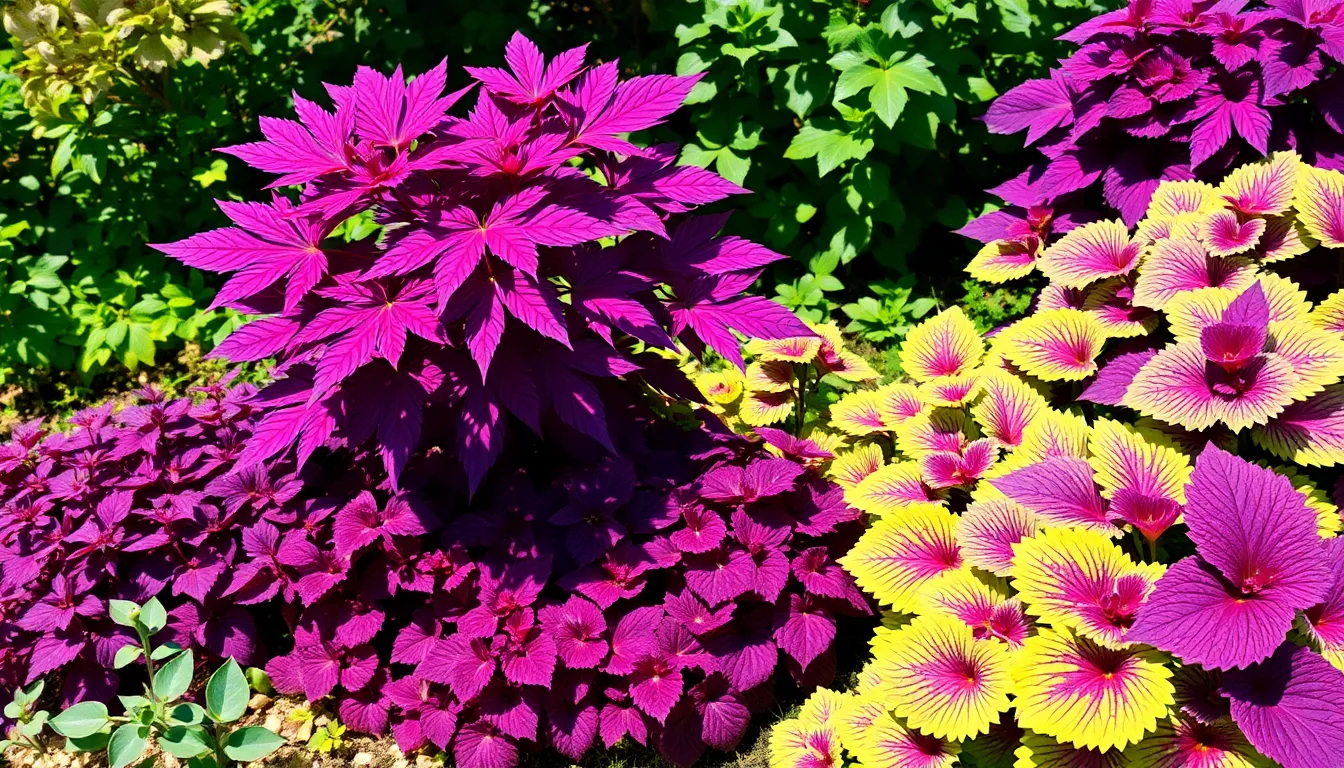
Outdoor gardens offer endless possibilities for showcasing dramatic purple foliage that creates stunning visual impact year-round. These carefully selected purple leaf plants thrive in various outdoor conditions while delivering the bold color contrasts that transform ordinary landscapes into extraordinary displays.
Japanese Maple (Acer palmatum)
Japanese Maple stands as one of the most elegant purple leaf trees for outdoor gardens, particularly in cultivars like ‘Bloodgood’ and ‘Atropurpureum.’ These slow-growing deciduous trees develop into small to medium-sized specimens that serve as stunning focal points in any industry design.
Deeply lobed palmate leaves create intricate textures while displaying rich purple to reddish-purple hues throughout the growing season. Fall transforms these already dramatic leaves into vibrant displays of color that extend the plant’s visual interest well into autumn months.
Care requirements include well-drained soil and partial shade to full sun exposure, depending on your exact cultivar selection. Protection from strong winds and intense afternoon sun becomes essential in hot climates to prevent leaf scorch and maintain optimal purple coloration.
Purple Heart (Setcreasea pallida)
Purple Heart delivers intense purple foliage with remarkable drought tolerance, making it perfect for low-maintenance outdoor gardens. This trailing perennial spreads as an effective ground cover or cascades beautifully from hanging baskets and elevated planters.
Elongated succulent-like leaves maintain their vibrant purple color throughout the growing season while producing delicate pink flowers that complement the dramatic foliage. Growth habits allow for versatile use in industry borders, container gardens, and mixed planting beds.
Thriving in full sun to partial shade conditions, Purple Heart tolerates drought stress better than most purple leaf plants. Well-drained soil prevents root rot while regular watering during establishment periods ensures vigorous growth and optimal color development.
Coleus (Plectranthus scutellarioides)
Coleus offers incredible variety in purple leaf patterns and shapes, ranging from deep burgundy solid colors to intricate variegated designs. These annual or tender perennial plants form bushy, compact growth habits that work perfectly in borders, containers, and mixed garden beds.
Wide leaf variety includes serrated edges, smooth margins, and unique textures that showcase purple tones alongside complementary colors like green, yellow, and red. Patterns range from subtle purple veining to bold solid purple leaves that create dramatic focal points.
Partial shade conditions suit Coleus best, though some varieties tolerate morning sun with adequate moisture. Well-drained soil combined with regular watering maintains the vibrant purple coloration while preventing common issues like root rot and leaf drop.
Low-Maintenance Purple Leaf Plants for Beginners
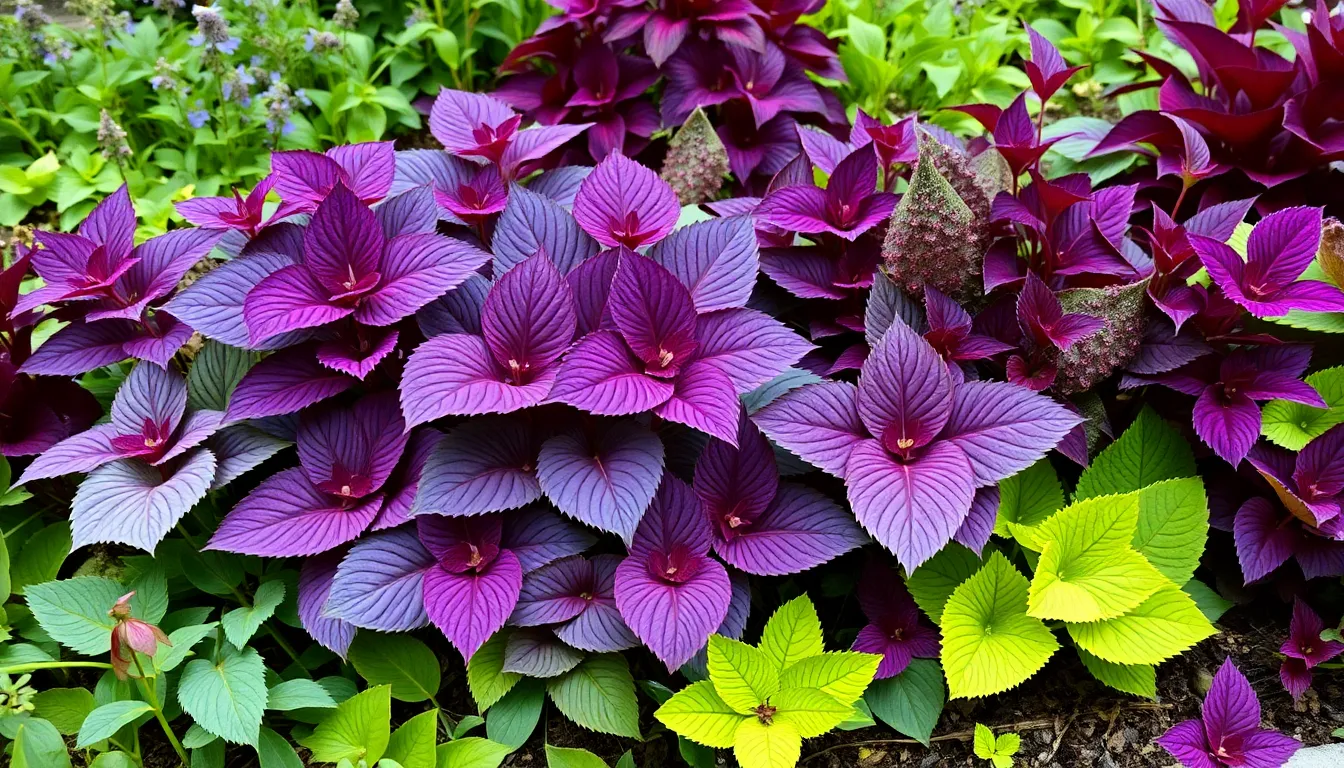
Starting your purple foliage journey doesn’t require extensive gardening experience. We’ve selected plants that thrive with minimal attention while delivering maximum visual impact.
Purple Oxalis (Oxalis triangularis)
Purple Oxalis transforms any space with its distinctive triangular leaves and charming white blooms. This adaptable plant showcases deep purple foliage that opens and closes throughout the day, creating an interactive garden experience. Growing conditions range from partial shade to full sun, making it perfect for various locations in your home or garden.
Watering requirements stay simple with this resilient plant. We recommend allowing the soil to dry slightly between waterings to prevent root rot. Moderate water schedules work best, typically every 7-10 days depending on your climate conditions.
Care becomes even easier during dormant periods when the plant naturally dies back. Simply reduce watering and wait for new growth to emerge in a few weeks.
Heuchera (Coral Bells)
Heuchera varieties offer stunning purple leaf colors that persist throughout multiple seasons. These perennial plants create excellent ground cover while providing consistent purple hues ranging from deep burgundy to lighter plum shades. Well-draining soil and partial shade locations help these plants establish strong root systems.
Regular watering supports healthy growth without creating waterlogged conditions. We suggest checking soil moisture weekly and watering when the top inch feels dry to the touch.
Fertilizing needs remain minimal with light applications during spring and early summer. These hardy perennials typically require division every 3-4 years to maintain vigorous growth and prevent overcrowding.
Persian Shield (Strobilanthes dyerianus)
Persian Shield creates dramatic garden displays with its vibrant purple leaves accented by distinctive silver markings. This tropical plant brings exotic appeal to any garden setting while remaining surprisingly easy to maintain. Partial shade locations with moist, well-draining soil provide optimal growing conditions.
Consistent moisture levels keep the foliage looking its best throughout the growing season. We maintain soil that feels slightly damp but never soggy, adjusting watering frequency based on weather conditions.
Pruning encourages bushier growth and maintains the plant’s attractive shape. Regular pinching of growing tips promotes new leaf development and prevents the plant from becoming leggy or sparse.
Purple Leaf Plants That Thrive in Full Sun
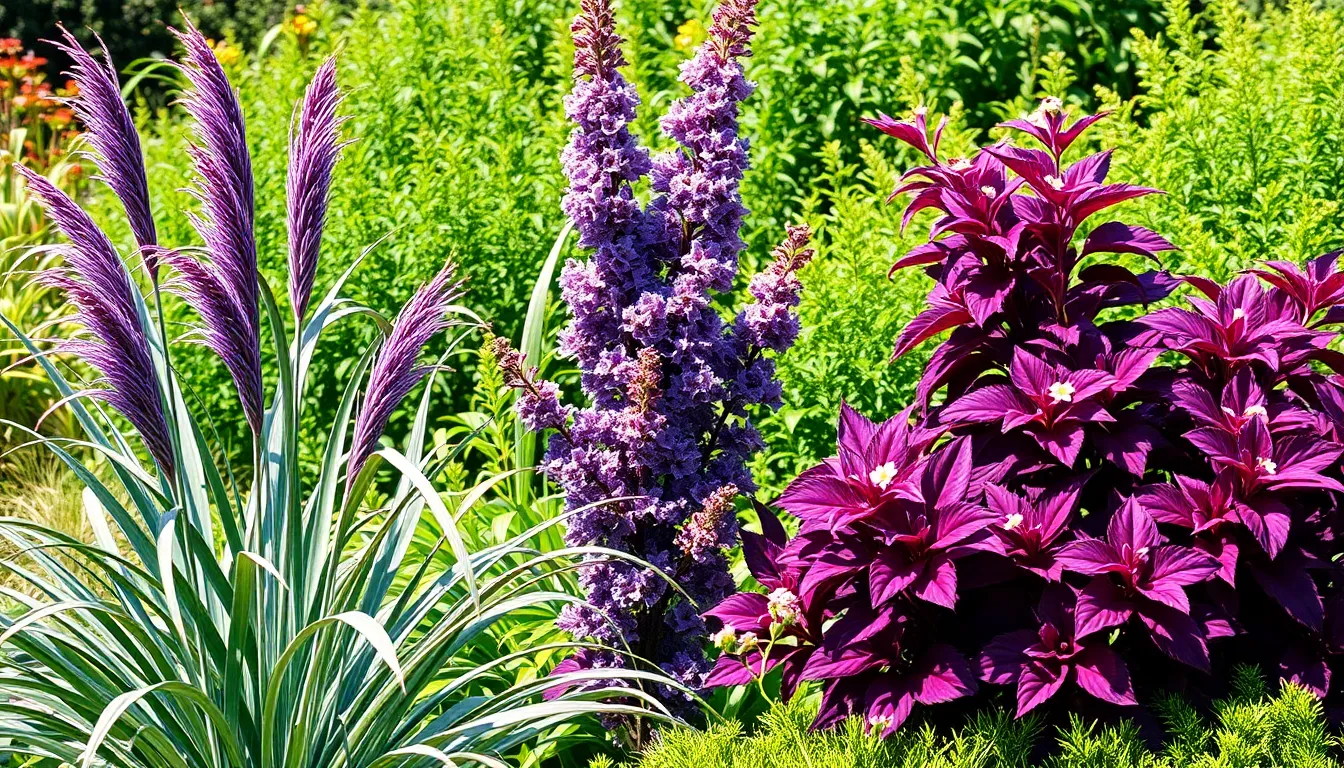
Full sun purple leaf plants bring dramatic color to your brightest garden spaces. These heat-loving varieties maintain their deep purple hues even under intense sunlight conditions.
Purple Fountain Grass (Pennisetum setaceum)
Purple fountain grass creates stunning architectural displays with its flowing purple foliage that moves gracefully in the breeze. This ornamental grass reaches heights of 3 to 5 feet while spreading 2 to 4 feet wide, making it perfect for creating natural privacy screens or dramatic focal points. We love using this grass in modern industry designs where its purple blades catch sunlight throughout the day.
The plant’s full sun requirements make it ideal for exposed areas where other purple foliage plants might struggle. Its drought tolerance means you’ll spend less time watering while still enjoying vibrant purple color all season long. Purple fountain grass works beautifully in mass plantings or as specimen plants in contemporary garden beds.
Smokebush (Cotinus coggygria)
Smokebush delivers some of the most intense purple foliage available in full sun gardens, growing 10 to 15 feet tall with an equal spread. This large shrub produces deep purple leaves that create striking contrast against its unique smoke-like flower clusters. We recommend smokebush for gardeners who want maximum visual impact from their purple leaf plants.
The plant adapts well to full sun or partial shade conditions, though full sun intensifies the purple coloration of its foliage. Smokebush requires minimal maintenance once established, making it perfect for low-maintenance industry designs. Its substantial size makes it ideal for creating natural boundaries or serving as a dramatic backdrop for smaller purple plants.
Purple-Leaf Sand Cherry (Prunus cistena)
Purple leaf sand cherry combines the beauty of purple foliage with the charm of flowering cherry trees in a compact 6 to 10 foot package. This shrub spreads 8 to 12 feet wide, creating substantial purple presence in full sun locations. We often see this plant used as a striking accent in foundation plantings where its purple leaves provide year-round color interest.
The plant’s adaptability to various soil conditions makes it suitable for challenging garden spots where other purple foliage options might fail. Purple leaf sand cherry produces small white or pink flowers in spring, adding seasonal interest beyond its constant purple leaf display. Its manageable size makes it perfect for smaller gardens where larger purple plants like smokebush might overwhelm the space.
Shade-Loving Purple Leaf Plants for Dark Corners
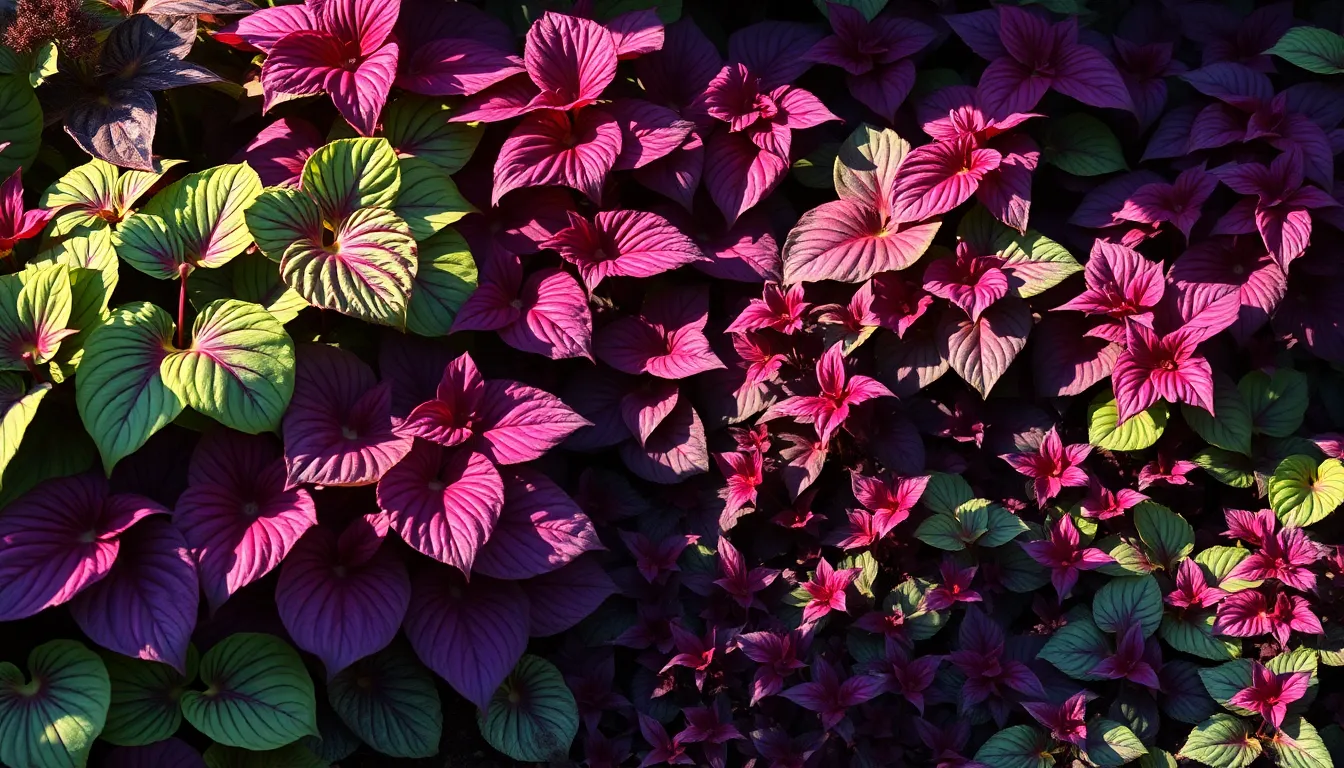
We can transform the darkest corners of our gardens with stunning purple leaf plants that thrive in low light conditions. These remarkable specimens bring vibrant color to areas where most flowering plants struggle to perform.
Caladium
Caladiums create spectacular displays with their broad heart shaped leaves adorned with striking purple or dark burgundy veins and patterns. These tropical perennials flourish in partial to full shade conditions, making them perfect choices for shaded garden beds and containers. Their foliage maintains vibrant colors throughout the entire growing season, providing consistent visual interest even in the darkest garden corners. We appreciate how these plants deliver dramatic color impact without requiring direct sunlight, making them invaluable for challenging shade locations.
Purple-Leaf Begonia
Begonias excel in shady locations while showcasing their remarkable purple foliage variations. Rex begonias display metallic deep purple and maroon tones with intricate leaf patterns that catch available light beautifully. These adaptable plants prefer indirect light conditions and consistent moisture levels, making them excellent selections for both indoor displays and shaded outdoor spaces. Their showy leaves create stunning focal points in areas where traditional flowering plants might fail to thrive.
Ajuga (Bugleweed)
Ajuga reptans stands out as a low growing spreading perennial featuring glossy purple or burgundy foliage complemented by blue or purple flowers. This hardy groundcover thrives in partial to full shade while tolerating a wide range of soil conditions with remarkable resilience. Popular cultivars like ‘Black Scallop’ showcase nearly black leaves that create dramatic contrast, while ‘Burgundy Glow’ offers variegated burgundy, rose, white, and green foliage patterns. Bugleweed establishes quickly and maintains itself easily, making it our top practical choice for covering dark corners with rich purple color.
Purple Leaf Plants Perfect for Container Gardening
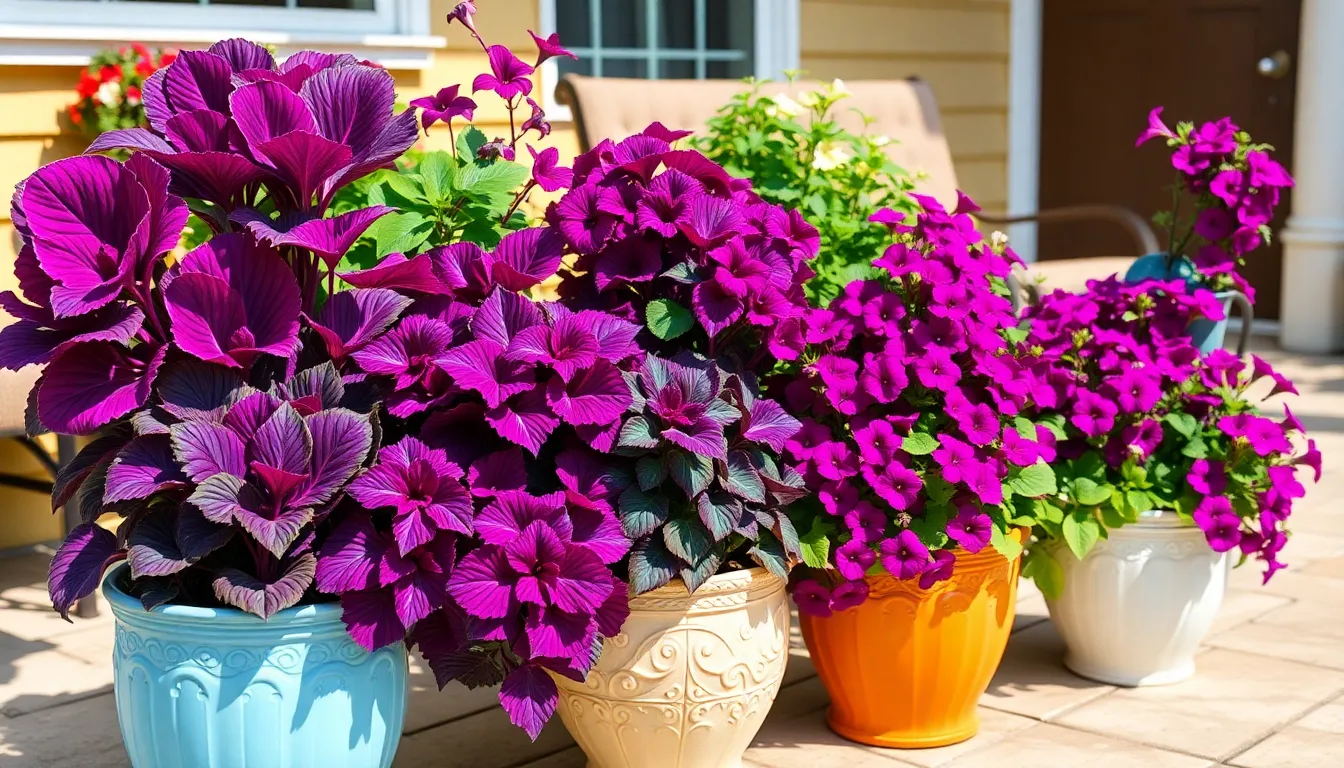
Container gardening opens up exciting possibilities for incorporating purple foliage into smaller spaces. We’ve selected these exceptional purple leaf plants that thrive in pots and planters.
Purple Cabbage (Brassica oleracea)
Purple cabbage brings vibrant burgundy hues to edible container gardens throughout cooler months. This cool-season crop displays stunning ruffled leaves that create eye-catching focal points in large planters or raised beds. We recommend positioning containers in locations that receive partial shade to full sun for optimal color development.
Growing this edible beauty requires well-draining potting mix and consistent moisture during its growing season. The deep purple leaves intensify as temperatures cool, making fall and early spring ideal planting times. Container cultivation allows us to move these plants to protect them from extreme weather while enjoying their ornamental and culinary benefits.
Purple Sweet Potato Vine (Ipomoea batatas)
Purple sweet potato vine creates cascading waterfalls of deep purple foliage that transform ordinary containers into dramatic displays. These vigorous vines excel in hanging baskets where their trailing stems can reach impressive lengths. We find their heart-shaped leaves provide excellent coverage while maintaining rich coloration throughout the growing season.
This heat-loving vine thrives in partial to full sun conditions and tolerates various soil types when grown in containers. Regular watering keeps the foliage lush and prevents stress that can fade the purple tones. The vine’s rapid growth makes it perfect for filling large containers quickly or creating living screens on patios and decks.
Purple Petunias
Purple petunias combine stunning flower power with deep purple-tinted foliage that enhances container arrangements. These popular annuals produce masses of blooms while their leaves display rich purple undertones that complement the floral display. We love using them in mixed containers where the purple foliage bridges the gap between different plant textures and colors.
Container-grown petunias require full sun to partial shade and benefit from regular deadheading to maintain continuous blooming. Their compact growth habit makes them ideal for window boxes, hanging baskets, and mixed plantings. The purple leaf varieties create sophisticated color schemes when paired with silver foliage plants or bright flowering companions.
Caring for Your Purple Leaf Plants
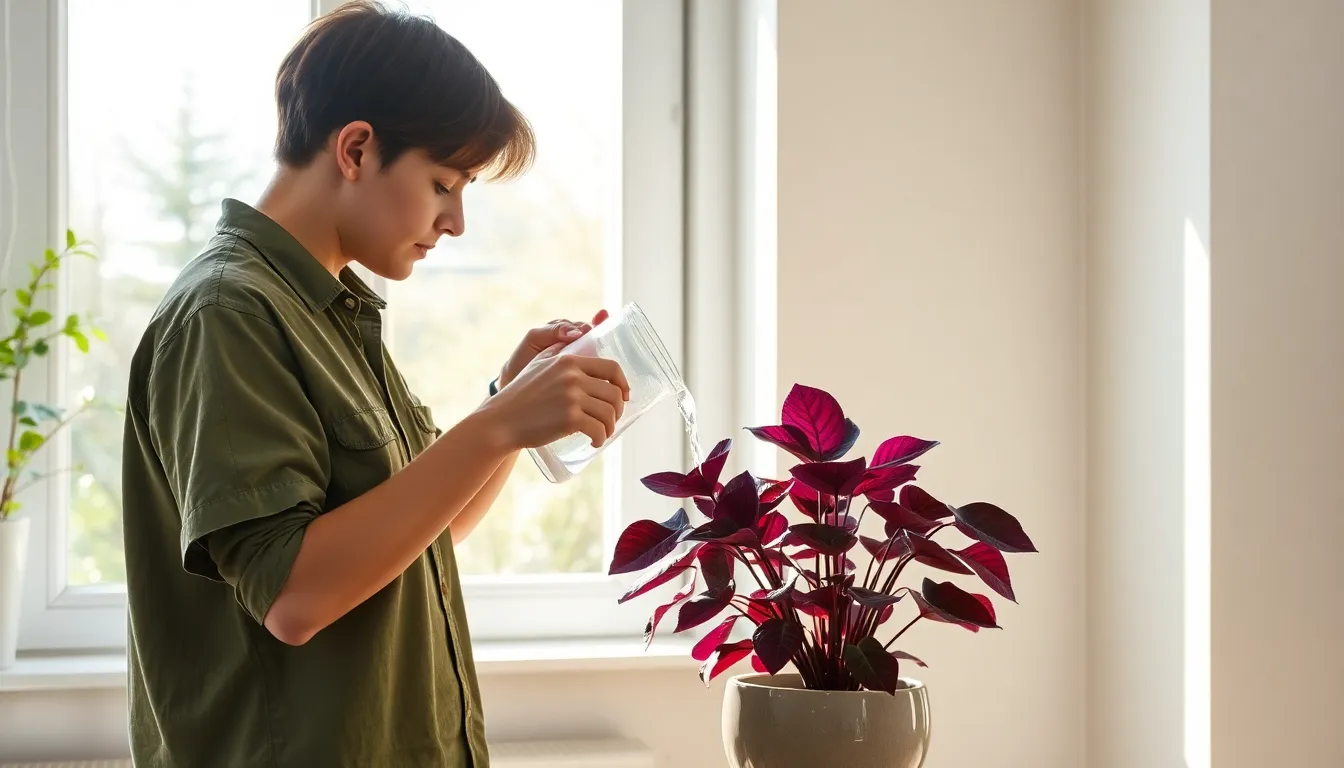
Maintaining these stunning purple specimens requires understanding their exact needs. Success with purple foliage plants depends on providing the right balance of light, water, nutrients, and environmental conditions.
Proper Lighting Requirements
Indirect bright light works best for preserving the vibrant purple colors in your foliage plants. Direct sunlight can scorch delicate leaves and fade their rich burgundy tones, so we recommend positioning plants near northern windows or behind sheer curtains.
Filtered light mimics their natural habitat conditions while protecting sensitive leaf tissues. Morning sun exposure followed by afternoon shade creates ideal lighting for most purple varieties. We’ve found that consistent indirect lighting helps maintain the deep plum colors that make these plants so captivating.
Plants receiving too little light often lose their purple intensity and revert to green shades. Rotating your containers weekly ensures even light distribution across all leaf surfaces. Artificial grow lights positioned 12-18 inches away provide excellent supplemental lighting during darker months.
Watering and Humidity Needs
Slightly moist soil without waterlogging creates the perfect growing environment for purple leaf plants. We water more frequently during active growing seasons in spring and summer, then reduce watering schedules throughout winter months when growth naturally slows.
Checking soil moisture levels 1-2 inches below the surface prevents both drought stress and root rot. Well draining potting mixes containing components like vermiculite help excess water escape while retaining adequate moisture for healthy root development.
Humidity requirements vary significantly among different purple foliage varieties. Plants like Purple Passion benefit from overall ambient humidity created by humidifiers rather than direct leaf misting, which can damage their fuzzy purple surfaces. We maintain humidity levels between 40-60% for optimal growth conditions.
Avoiding excess moisture on leaf surfaces prevents fungal diseases that commonly affect purple plants. Bottom watering techniques allow roots to absorb needed moisture while keeping foliage completely dry.
Fertilizing Purple Foliage Plants
Monthly feeding during spring and summer months supports vigorous growth and maintains intense purple coloration. We dilute all purpose liquid fertilizer to half strength to prevent nutrient burn on sensitive root systems.
Winter fertilizing schedules should decrease to once monthly applications since plant metabolism slows considerably during cooler months. Over fertilizing can actually reduce purple pigmentation by encouraging excessive green chlorophyll production.
Balanced fertilizers containing equal amounts of nitrogen, phosphorus, and potassium work well for most purple varieties. Plants grown in containers require more frequent feeding than those planted directly in garden soil since nutrients leach out through drainage holes.
Signs of proper fertilization include steady new growth with maintained purple intensity. We monitor leaf color changes as indicators of whether our feeding schedules need adjustment for optimal results.
Common Problems with Purple Leaf Plants
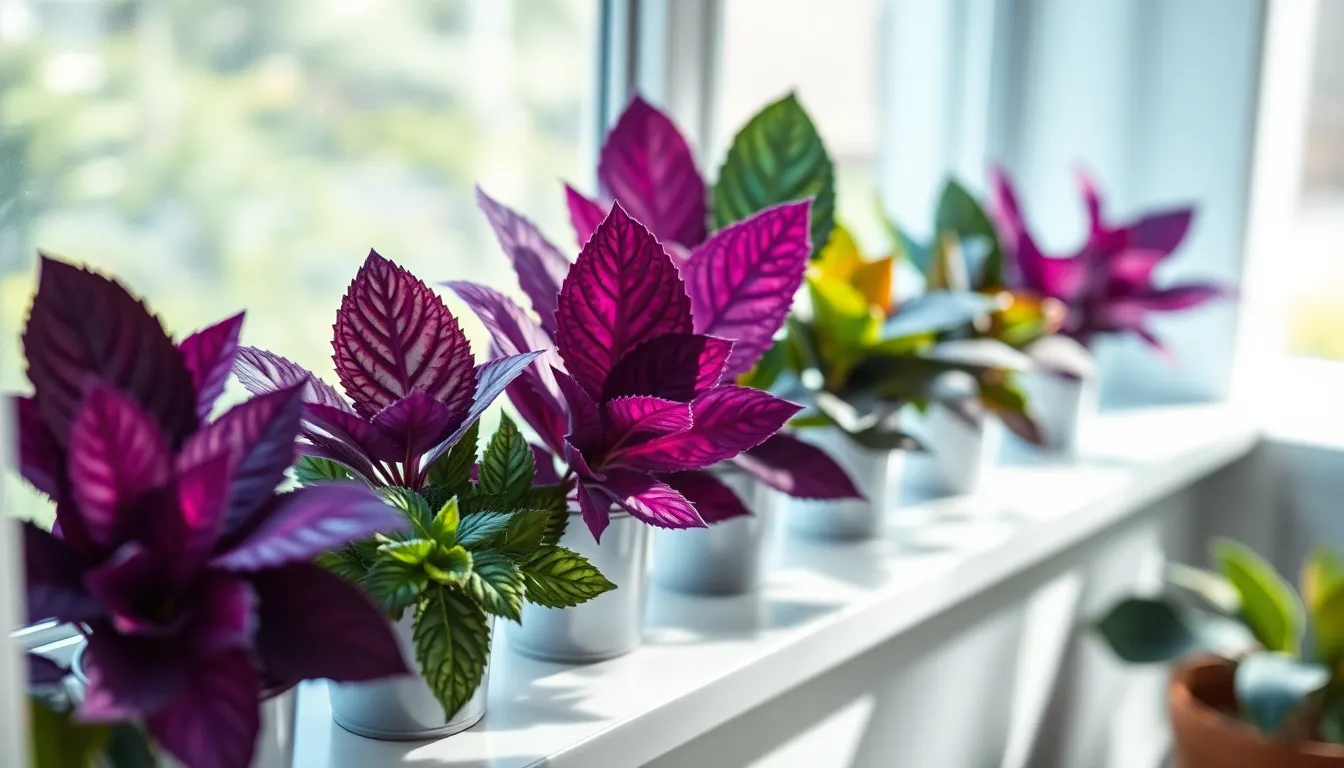
Purple leaf plants can encounter several challenges that affect their stunning appearance and overall health. Understanding these common issues helps us maintain vibrant foliage throughout the growing season.
Color Fading Issues
Insufficient Light causes purple leaf plants to lose their vibrant coloration as they struggle to maintain their natural pigments. Moving plants to locations with bright, indirect light restores their rich purple hues without risking sun damage.
Excessive Direct Sunlight bleaches purple foliage and creates pale, washed-out appearances in sensitive varieties. We recommend filtering harsh afternoon sun through sheer curtains or relocating plants to areas with morning sun exposure.
Nutrient Deficiencies rob purple plants of essential elements needed for color production and maintenance. Fertilizing with balanced plant food every 4-6 weeks during growing season supports vibrant pigment development.
Improper Watering stresses purple leaf plants and diminishes their color intensity over time. Maintaining consistent moisture levels without waterlogging helps preserve the deep purple tones we love.
Pest and Disease Management
Aphids cluster on purple leaf undersides and drain plant energy while spreading diseases. Regular inspections every few days and immediate treatment with insecticidal soap controls these common pests effectively.
Spider Mites create fine webbing on purple foliage and cause stippled yellow spots throughout affected leaves. Increasing humidity around plants and using miticide sprays eliminates these microscopic pests quickly.
Caterpillars chew irregular holes in purple leaves and can defoliate entire plants within days. Hand-picking larger caterpillars and applying organic Bt spray prevents extensive damage to our purple specimens.
Powdery Mildew appears as white dusty coating on purple leaf surfaces during humid conditions. Improving air circulation and avoiding wet foliage prevents this fungal infection from spreading.
Leaf Spot Diseases create brown or black circular spots that expand across purple foliage rapidly. Removing affected leaves immediately and applying copper-based fungicides stops disease progression.
Root Rot develops when purple plants sit in waterlogged soil and causes yellowing leaves plus stunted growth. Ensuring proper drainage and adjusting watering frequency prevents this serious condition.
Seasonal Care Adjustments
Spring and Summer require increased attention to watering and light management as purple plants enter active growth phases. We maintain bright, indirect light exposure while watering when top inch of soil feels dry.
Fall Preparation involves reducing fertilization frequency and gradually decreasing water amounts as purple plants slow their growth. This seasonal adjustment prevents nutrient burn and root problems during dormant periods.
Winter Care demands minimal watering and complete fertilizer cessation for most purple leaf varieties. We water only when soil becomes quite dry and avoid fertilizing until spring growth resumes.
Temperature Fluctuations stress purple plants and cause leaf curling or dropping throughout seasonal transitions. Maintaining stable indoor temperatures between 65-75°F protects sensitive purple foliage from thermal shock.
Conclusion
Purple leaf plants offer endless possibilities for creating stunning garden displays that captivate year-round. Whether you’re designing indoor sanctuaries or transforming outdoor landscapes these remarkable specimens deliver unmatched visual drama with relatively simple care requirements.
We’ve explored options for every gardening scenario – from sun-loving varieties that thrive in bright exposures to shade-tolerant species perfect for darker corners. Container gardening enthusiasts can achieve spectacular results while beginners will find plenty of low-maintenance choices to start their purple foliage journey.
The key to success lies in understanding each plant’s exact needs and watching for common issues before they become problems. With proper attention to lighting watering and seasonal care adjustments your purple leaf plants will reward you with vibrant colors and healthy growth that elevate any space into something truly extraordinary.
Frequently Asked Questions
What are the best purple leaf plants for beginners?
Purple Oxalis (Oxalis triangularis), Heuchera (Coral Bells), and Persian Shield are excellent choices for beginners. These plants require minimal care while providing stunning purple foliage. Purple Oxalis adapts to various light conditions, Heuchera maintains color through seasons with regular watering, and Persian Shield thrives in partial shade with consistent moisture. All three are forgiving and perfect for novice gardeners starting their purple foliage journey.
Can purple leaf plants grow indoors?
Yes, many purple leaf plants thrive indoors. African Violets offer compact rosettes with deep purple leaves, Purple Passion Plants cascade beautifully in hanging baskets with soft purple hairs, and Tradescantia Zebrina provides striking silver-striped leaves with purple undersides. These indoor varieties require proper lighting, consistent watering, and appropriate humidity levels to maintain their vibrant colors and healthy growth.
Which purple leaf plants work best in full sun?
Purple Fountain Grass, Smokebush, and Purple-Leaf Sand Cherry excel in full sun conditions. Purple Fountain Grass offers flowing foliage with excellent drought tolerance, Smokebush provides intense purple leaves with minimal maintenance requirements, and Purple-Leaf Sand Cherry combines beautiful foliage with seasonal flowers. These plants are specifically adapted to handle direct sunlight while maintaining their rich purple coloration.
Do purple leaf plants need special care?
Purple leaf plants require attention to lighting, watering, and nutrition to maintain vibrant colors. They typically need indirect bright light to preserve color intensity, consistent but not excessive watering, and monthly fertilization during growing season. Proper humidity levels and protection from extreme conditions help maintain their health. Understanding each variety’s specific needs ensures successful cultivation and long-lasting purple foliage.
Why are my purple leaves turning green?
Purple leaves often turn green due to insufficient light or excessive direct sunlight, which can bleach vibrant hues. Nutrient imbalances, particularly nitrogen excess, can also cause color fading. Poor watering practices and seasonal changes affect pigmentation. To restore color, adjust lighting conditions, maintain proper fertilization schedules, ensure consistent watering, and provide appropriate seasonal care based on your plant’s specific requirements.
What purple leaf plants grow well in containers?
Purple Cabbage offers vibrant burgundy hues perfect for edible container gardens, Purple Sweet Potato Vine provides cascading foliage ideal for hanging baskets, and Purple Petunias combine stunning blooms with rich purple undertones. These container plants adapt well to pot restrictions while maintaining their striking appearance. Regular watering, proper drainage, and appropriate fertilization ensure optimal growth and visual impact in smaller spaces.
Can purple leaf plants survive in shade?
Several purple leaf plants thrive in shaded conditions. Caladiums feature broad heart-shaped leaves with striking purple veins, Purple-Leaf Begonias display metallic deep purple tones with intricate patterns, and Ajuga serves as resilient groundcover with glossy purple foliage. These shade-loving varieties are specifically adapted to low-light environments and can transform dark garden corners into colorful displays.
How often should I water purple leaf plants?
Watering frequency depends on the specific plant variety, growing conditions, and season. Most purple leaf plants prefer consistent moisture without waterlogging. Check soil moisture regularly – water when the top inch feels dry. Indoor plants typically need weekly watering, while outdoor plants may require more frequent watering during hot weather. Always ensure proper drainage to prevent root rot and maintain healthy purple foliage.
